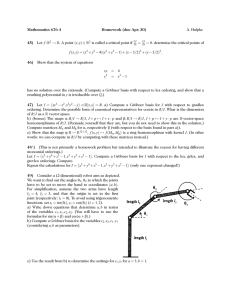Mathematics 567 Homework (due Mar 31) 35) A. Hulpke
advertisement
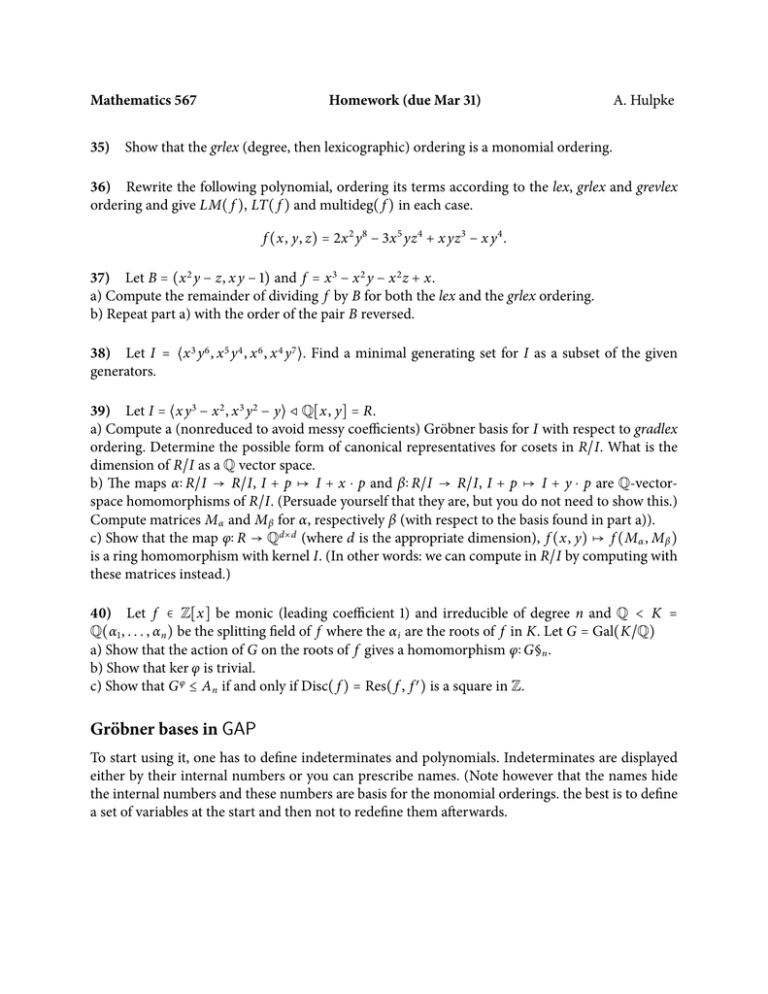
Mathematics 567 Homework (due Mar 31) A. Hulpke 35) Show that the grlex (degree, then lexicographic) ordering is a monomial ordering. 36) Rewrite the following polynomial, ordering its terms according to the lex, grlex and grevlex ordering and give LM( f ), LT( f ) and multideg( f ) in each case. f (x, y, z) = 2x 2 y 8 − 3x 5 yz 4 + x yz 3 − x y 4 . 37) Let B = (x 2 y − z, x y − 1) and f = x 3 − x 2 y − x 2 z + x. a) Compute the remainder of dividing f by B for both the lex and the grlex ordering. b) Repeat part a) with the order of the pair B reversed. 38) Let I = ⟨x 3 y 6 , x 5 y 4 , x 6 , x 4 y 7 ⟩. Find a minimal generating set for I as a subset of the given generators. 39) Let I = ⟨x y3 − x 2 , x 3 y 2 − y⟩ ⊲ Q[x, y] = R. a) Compute a (nonreduced to avoid messy coefficients) Gröbner basis for I with respect to gradlex ordering. Determine the possible form of canonical representatives for cosets in R/I. What is the dimension of R/I as a Q vector space. b) The maps α∶ R/I → R/I, I + p ↦ I + x ⋅ p and β∶ R/I → R/I, I + p ↦ I + y ⋅ p are Q-vectorspace homomorphisms of R/I. (Persuade yourself that they are, but you do not need to show this.) Compute matrices M α and M β for α, respectively β (with respect to the basis found in part a)). c) Show that the map φ∶ R → Qd×d (where d is the appropriate dimension), f (x, y) ↦ f (M α , M β ) is a ring homomorphism with kernel I. (In other words: we can compute in R/I by computing with these matrices instead.) 40) Let f ∈ Z[x] be monic (leading coefficient 1) and irreducible of degree n and Q < K = Q(α1 , . . . , α n ) be the splitting field of f where the α i are the roots of f in K. Let G = Gal(K/Q) a) Show that the action of G on the roots of f gives a homomorphism φ∶ G§n . b) Show that ker φ is trivial. c) Show that G φ ≤ A n if and only if Disc( f ) = Res( f , f ′ ) is a square in Z. Gröbner bases in GAP To start using it, one has to define indeterminates and polynomials. Indeterminates are displayed either by their internal numbers or you can prescribe names. (Note however that the names hide the internal numbers and these numbers are basis for the monomial orderings. the best is to define a set of variables at the start and then not to redefine them afterwards. gap> x_1 gap> x gap> y gap> 2 x:=X(Rationals,1); # number x:=X(Rationals,"x"); y:=X(Rationals,"y"); IndeterminateNumberOfUnivariateLaurentPolynomial(y); The three orders from the lecture are defined as MonomialLexOrdering(), MonomialGrlexOrdering() and MonomialGrevlexOrdering(). LeadingTerm gives the leading term of a polynomial. gap> LeadingTerm(x*y^2+2*x^2*y,MonomialGrlexOrdering()); 2*x^2*y GrobnerBasis computes a Gröbner basis. (You can set the info level as done here to get some information about the calculations.) gap> B:=[x*y-y^2,y^2-x]; [ x*y-y^2, -x+y^2 ] gap> GrobnerBasis(B,MonomialGrlexOrdering()); [ x*y-y^2, y^2-x, -x^2+x ] gap> G:=ReducedGroebnerBasis(B,MonomialLexOrdering()); [ y^2-x, x*y-x, x^2-x ] PolynomialReduction can be used to determine remainders. The first entry is the remainder, the second the coefficients with respect to the list of basis elements. (Note that the division algorithm works slightly different than the one in the book, thus if G is not a Gröbner basis you might get different remainders.) gap> PolynomialReduction(x^5*y,G,MonomialGrlexOrdering()); [ x, [ x^4+x^3*y+x^2*y^2+x*y^3+y^4+y^3+y^2+y+1, y^4+y^3+y^2+y+1, 0 ] ] If you want to change the variable ordering, you can give it as an argument to the ordering. For example to change to an order y > x we could do: gap> G:=ReducedGroebnerBasis(B,MonomialGrlexOrdering(y,x)); [ x^2-x, x*y-x, y^2-x ]

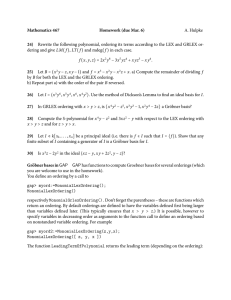



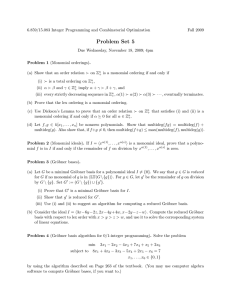


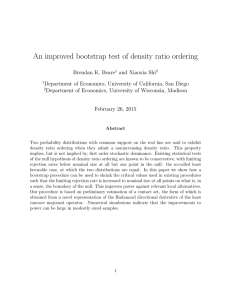

![Exercise 1: [a] = 12*j + a [b] = 12*k + b](http://s2.studylib.net/store/data/014977059_1-ae774184c05da6057cb2477c74556684-300x300.png)
